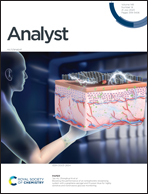A polyaniline functionalized NiFeP nanosheet array-based electrochemical immunosensor using Au/Cu2O nanocubes as a signal amplifier for the detection of SARS-CoV-2 nucleocapsid protein†
Abstract
Coronavirus disease 2019 (COVID-19) is an infectious disease caused by severe acute respiratory syndrome coronavirus 2 (SARS-CoV-2), which emerged as a novel pathogen in 2019. The virus is responsible for a severe acute respiratory syndrome outbreak, affecting the respiratory system of infected individuals. COVID-19 is a super amplifier of basic diseases, and the disease with basic diseases is often more serious. Controlling the spread of the COVID-19 pandemic relies heavily on the timely and accurate detection of the virus. To resolve the problem, a polyaniline functionalized NiFeP nanosheet array-based electrochemical immunosensor using Au/Cu2O nanocubes as a signal amplifier is fabricated for the detection of SARS-CoV-2 nucleocapsid protein (SARS-CoV-2 NP). Polyaniline (PANI) functionalized NiFeP nanosheet arrays are synthesized as an ideal sensing platform for the first time. PANI is coated on the surface of NiFeP by electropolymerization to enhance biocompatibility, beneficial for the efficient loading of the capture antibody (Ab1). Significantly, Au/Cu2O nanocubes possess excellent peroxidase-like activity and exhibit outstanding catalytic activity for the reduction of H2O2. Therefore, Au/Cu2O nanocubes combine with a labeled antibody (Ab2) through the Au–N bond to form labeled probes, which can effectively amplify current signals. Under optimal conditions, the immunosensor for the detection of SARS-CoV-2 NP shows a wide linear range of 10 fg mL−1–20 ng mL−1 and a low detection limit of 1.12 fg mL−1 (S/N = 3). It also exhibits desirable selectivity, repeatability, and stability. Meanwhile, the excellent analytical performance in human serum samples confirms the practicality of the PANI functionalized NiFeP nanosheet array-based immunosensor. The electrochemical immunosensor based on the Au/Cu2O nanocubes as a signal amplifier demonstrates great potential for application in the personalized point-of-care (POC) clinical diagnosis.



 Please wait while we load your content...
Please wait while we load your content...